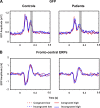Reduced frontal theta oscillations indicate altered crossmodal prediction error processing in schizophrenia
- PMID: 27358314
- PMCID: PMC5040384
- DOI: 10.1152/jn.00096.2016
Reduced frontal theta oscillations indicate altered crossmodal prediction error processing in schizophrenia
Abstract
Our brain generates predictions about forthcoming stimuli and compares predicted with incoming input. Failures in predicting events might contribute to hallucinations and delusions in schizophrenia (SZ). When a stimulus violates prediction, neural activity that reflects prediction error (PE) processing is found. While PE processing deficits have been reported in unisensory paradigms, it is unknown whether SZ patients (SZP) show altered crossmodal PE processing. We measured high-density electroencephalography and applied source estimation approaches to investigate crossmodal PE processing generated by audiovisual speech. In SZP and healthy control participants (HC), we used an established paradigm in which high- and low-predictive visual syllables were paired with congruent or incongruent auditory syllables. We examined crossmodal PE processing in SZP and HC by comparing differences in event-related potentials and neural oscillations between incongruent and congruent high- and low-predictive audiovisual syllables. In both groups event-related potentials between 206 and 250 ms were larger in high- compared with low-predictive syllables, suggesting intact audiovisual incongruence detection in the auditory cortex of SZP. The analysis of oscillatory responses revealed theta-band (4-7 Hz) power enhancement in high- compared with low-predictive syllables between 230 and 370 ms in the frontal cortex of HC but not SZP. Thus aberrant frontal theta-band oscillations reflect crossmodal PE processing deficits in SZ. The present study suggests a top-down multisensory processing deficit and highlights the role of dysfunctional frontal oscillations for the SZ psychopathology.
Keywords: audiovisual speech; multisensory processing; neural synchrony; oscillatory activity; predictive coding.
Copyright © 2016 the American Physiological Society.
Figures








Similar articles
-
Early evoked brain activity underlies auditory and audiovisual speech recognition deficits in schizophrenia.Neuroimage Clin. 2022;33:102909. doi: 10.1016/j.nicl.2021.102909. Epub 2021 Dec 8. Neuroimage Clin. 2022. PMID: 34915330 Free PMC article.
-
Early and late beta-band power reflect audiovisual perception in the McGurk illusion.J Neurophysiol. 2015 Apr 1;113(7):2342-50. doi: 10.1152/jn.00783.2014. Epub 2015 Jan 7. J Neurophysiol. 2015. PMID: 25568160 Free PMC article.
-
Speech-specific audiovisual integration modulates induced theta-band oscillations.PLoS One. 2019 Jul 16;14(7):e0219744. doi: 10.1371/journal.pone.0219744. eCollection 2019. PLoS One. 2019. PMID: 31310616 Free PMC article.
-
Prediction and constraint in audiovisual speech perception.Cortex. 2015 Jul;68:169-81. doi: 10.1016/j.cortex.2015.03.006. Epub 2015 Mar 20. Cortex. 2015. PMID: 25890390 Free PMC article. Review.
-
Neural Oscillations Orchestrate Multisensory Processing.Neuroscientist. 2018 Dec;24(6):609-626. doi: 10.1177/1073858418755352. Epub 2018 Feb 9. Neuroscientist. 2018. PMID: 29424265 Review.
Cited by
-
A systematic review of the neural correlates of multisensory integration in schizophrenia.Schizophr Res Cogn. 2021 Oct 5;27:100219. doi: 10.1016/j.scog.2021.100219. eCollection 2022 Mar. Schizophr Res Cogn. 2021. PMID: 34660211 Free PMC article.
-
Multi-timescale neural dynamics for multisensory integration.Nat Rev Neurosci. 2024 Sep;25(9):625-642. doi: 10.1038/s41583-024-00845-7. Epub 2024 Aug 1. Nat Rev Neurosci. 2024. PMID: 39090214 Review.
-
ERP and oscillatory differences in overweight/obese and normal-weight adolescents in response to food stimuli.J Eat Disord. 2020 Apr 7;8:14. doi: 10.1186/s40337-020-00290-8. eCollection 2020. J Eat Disord. 2020. PMID: 32280464 Free PMC article.
-
Low-frequency oscillations reflect aberrant tone restoration during the auditory continuity illusion in schizophrenia.Sci Rep. 2020 Jul 17;10(1):11872. doi: 10.1038/s41598-020-68414-3. Sci Rep. 2020. PMID: 32681138 Free PMC article.
-
Abnormal theta and alpha oscillations in children and adolescents with first-episode psychosis and clinical high-risk psychosis.BJPsych Open. 2024 Mar 22;10(2):e71. doi: 10.1192/bjo.2024.32. BJPsych Open. 2024. PMID: 38515342 Free PMC article.
References
-
- Arnal LH, Giraud AL. Cortical oscillations and sensory predictions. Trends Cogn Sci 16: 390–398, 2012. - PubMed
-
- Arnal LH, Wyart V, Giraud AL. Transitions in neural oscillations reflect prediction errors generated in audiovisual speech. Nat Neurosci 14: 797–801, 2011. - PubMed
-
- Brainard DH. The Psychophysics Toolbox. Spat Vis 10: 433–436, 1997. - PubMed
Publication types
MeSH terms
LinkOut - more resources
Full Text Sources
Other Literature Sources
Medical
Miscellaneous

